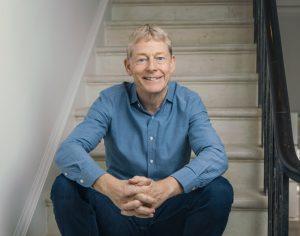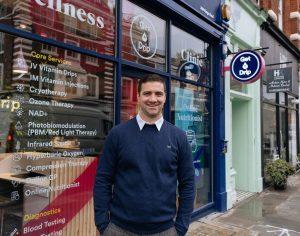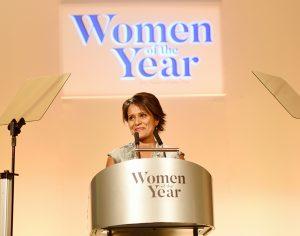Seriously, knowing that the Dalai Lama loves the high-tech prostheses she helped create isn’t even the biggest thing that’s happened to Samantha Payne this year. The Tibetan world leader met one of the Open Bionics’ ambassadors and double-amputee Tilly Lockey at an event in The Netherlands in September 2018. During the conversation, he suddenly reached over, put his hands on one of her two multi-grip artificial hands and said how much he appreciated the work that had gone into creating the devices. “It’s pretty intense,” says Payne.
Still, as the co-founder and COO of Open Bionics, the startup using 3D-printers and some ingenious engineering to create pioneering prostheses, Payne is keeping more than busy these days. “It’s been a bit of a whirlwind,” she says. Since the company’s first medically-approved bionic arm went on sale in April, the Hero Arm and the people using it have popped up everywhere from TV morning shows and O2 ads to being praised by religious leaders. “We’re just grateful our users are now using their devices, that they are out in the wild and that all these sort of opportunities came about because more people now wear the device so more people are interested, want to talk about it and find out about their limb difference, which is pretty cool,” she says.
These achievements are even more encouraging considering the story Payne kept hearing at the beginning of her journey. “Adult amputees told us that as young kids getting a prosthetic arm, whether it was a hook or a prosthesis, they would be bullied and it would create such a bad social stigma that it was often something they carried with them later in life,” she remembers. “They had this huge body confidence issue where they felt they had to hide their limb because of the horrible experience they had as a child.” So when she and her co-founder and CEO Joel Gibbard set out to develop the next generation of bionic limbs, they were determined no one should be made to feel that way again. And thanks to collaborations with Disney and game developers like Eidos Montréal, Open Bionics has been able to develop high-tech arms that look and feel like they’re taken right out of the page of a comic. “We want them to have the superhero narrative so when they go into school they have the official Iron Man hand and only they can have it because it’s still a medical device,” Payne says. “It’s a prosthetic bionic arm and it does things enabling them to do more of the stuff that their peers can do but it also looks really cool. It’s stylish and desirable. Those kids will get a completely different response when they go to school.”
And it’s not just the stigma that affects hand amputees but also the cost. A high-tech bionic arm can cost up to £100,000. In comparison, Open Bionics’ new Hero Arm costs between £8,500 and £9,999 from private prosthetic clinics thanks to it being 3D-printed and therefore more cost-effective to produce.

However, upon first meeting her co-founder Payne had no idea she’d end up teaming up with him. Instead, when she established herself as a freelance reporter in Bristol in 2013, she initially set out to report about the city’s emerging startup ecosystem and not to become an entrepreneur. “When I moved here it was kind of all just starting,” she says. And it was in this capacity that she came across something called The Open Hand Project led by her future co-founder.
She came away from the interview having been truly impressed with Gibbard. “Joel is a bit of a genius,” she laughs. “He is an incredible maker and engineer. He built his first robot when he was seven years old. His parents had asked him to do the chores and clean the kitchen. So he built a robot out of Lego and Meccano on wheels that sprayed cleaning detergent from the front of the robot with a motor controlled cloth behind it, wiping the kitchen floor.” Over the years, Gibbard nurtured this love for engineering, tinkering and innovation. He eventually found his calling at 17 when he realised how dependent he was of his own hands to build things. “So he went about trying to make a hand,” Payne explains.
Gibbard nurtured his interest for making high-tech hands throughout his university studies, spurred on by the realisation that less than 1% of the population had access to multi-grip bionic arms. But he had to fight to keep developing the project. “The university told him the project he was undertaking was too ambitious technologically and that he wouldn’t be able to do it,” Payne explains. Eventually his lecturers relented and allowed him to keep developing the idea. The result? Their minds were thoroughly blown by his work. “They actually awarded him a prize at the end of his degree because the research was so great,” Payne says. It was this research that led Gibbard to launch The Open Hand Project to help develop affordable and open sourced hands.
And that’s how the two future co-founders met. “I went to interview him as a journalist because the project and the crowdfunding campaign were a huge success,” she says. “It seemed like a brilliant idea. It was really radical, really novel. A very philanthropic idea to take a technology that’s currently very elite and completely democratise it. It was a really great story at the time.” Fortunately, the story didn’t end there. “Joel called me back after the interview and told me about a startup competition that he’d found and he needed help writing a pitch and that’s how I got involved,” she remembers.
The competition in question was Intel’s Make it Wearable and the prize pot stood at $50,000. “We weren’t expecting to win,” she admits. “We were up against engineers and people from Google and Stanford. Really, we were just out of our depth. So it was a shock when we won.” With the prize money in hand Gibbard and Payne suddenly had the funds to hire a team and develop a real prototype of the business. “That capital gave us a huge lift-off,” she says. So in 2014 the co-founders had everything in place to launch Open Bionics for real.

Most tech startups are struggling to fill vacancies due to the UK’s huge STEM skills shortage. Fortunately, Open Bionics has never struggled to source talent. “We’re quite lucky because we’re based in Bristol, which is a hub for engineering,” Payne explains. Not only is the city home to companies like Airbus UK and Dyson but it’s also within the vicinity of several strong engineering universities. Open Bionics’ recruitment ability is quite enhanced thanks to the company’s potent online following. “Whenever we have something going, we’re really lucky to receive a lot of applications,” Payne says.
The founders have always been very particular about the culture they nurture and the candidates they hire. “The kind of person that works at Open Bionics seems to be a maker,” Payne explains. “Everyone seems to make stuff on their own time. They like to share their makes and their hobbies and [we have] geeky activities with the team and everyone is highly creative. I think we’ve managed to collect a group of people who are very complimentary in terms of their personalities.” The founders also organise things like Mario Kart games, Fridays when everyone can work on their own personal projects, camping trips and stimulate a fun and open environment. “We encourage the social aspect of the startup culture,” Payne says.
But it wasn’t just having the team and the cash injection that set them upon the path of entrepreneurial success – the prize also included a spot at UC Berkeley Haas School of Business’ accelerator. That’s where the founders learned about the lean startup method. “There’s two main models that I’ve come across,” Payne explains. “It’s the ‘raise as much as you can as fast as you can and develop as fast as you can to beat all of the competition’ kind. Or [you can be] a lean [startup] where you keep as much equity as you can and you go slow and steady.”
These insights set the tone for Open Bionics’ future funding strategy. Instead of opting for the traditional VC route, the founders decided to focus on winning as many grants and competitions they could. And the strategy has certainly proven successful. Over the years the startup has won such coveted trophies like the James Dyson Award for Engineering, a Wired Social Innovation Award, a Limbless Association Prosthetic Innovation of the Year Award and a $1m UAE AI & Robotics International Award for Good. Most recently, Open Bionics picked up the title of being among the 2018 Hottest Startup Founders in Europe at The Europa Awards. Winning all these competitions also set it up for when it would feel ready to include investors in the future. “I think it’s a really good sign when your business is being recognised as a game-changer, as someone doing something different in an industry,” Payne says.

A second huge takeaway from the accelerator was the importance of intimately working with the amputee community. “When you’re building a product you should work very closely to the end user,” Payne argues. Recognising this, Open Bionics spent months talking with amputees to find out more about their experience of using artificial limbs. Not only did the founders find out about the stigma associated with the loss of a limb but also realised how many developers get the product wrong by turning it into something clinical and boring that doesn’t showcase the user’s personality. Other times it heard about how heavy and uncomfortable arms were. It’s hardly surprising then that NHS England reports that up to 20% of adults with upper limb amputations choose not to use prosthetics. Of those who do, 26% of adults and 45% of children and teens are unhappy with their device. “Amputees were telling us what they wanted was something that was personalised, something where they could change the look, something where they could choose to adapt and accessorise,” Payne remembers.
Following these insights, the co-founders began playing around with the idea of creating a hand that could turn amputees into superheroes. The only snag was that they lacked the appropriate licences to use designs resembling those from the Marvel Cinematic Universe. That’s when they were encouraged to sign up for Disney’s Techstars accelerator. “It seemed like the perfect opportunity because we’d approached Disney in the past through their lawyers and it clearly didn’t go anywhere,” Payne says. Open Bionics joined the programme in 2015 but the real magic happened when a Hollywood director heard them pitch and asked if Kathleen Kennedy, the president of Lucasfilm, knew about their project. “He said, ‘she’d love this, let me just email her,’” Payne remembers. “And he just got out his phone and wrote an email to Kathleen Kennedy and explained the project and she emailed us back and said, ‘Okay, this sounds great, let’s do this.’”
With the blessing of the of Star Wars owner, Open Bionics suddenly had access to Disney’s design teams. The result was three arms inspired by Iron Man, Star Wars and Frozen. “Those were the first three that we announced through the accelerator programme but we still have more to come,” Payne says. While she won’t reveal what other characters have inspired the upcoming arms, Payne promises that it’s going to be worth the wait. “Watch this space,” she laughs.

But Disney isn’t the only company the startup has worked with. Open Bionics also collaborated with video game manufacturer Eidos Montréal in 2016 to create a bionic arm based on the video game Deus Ex. “It’s really cool because we’re working with world-class artists and what we set out to do with our bionic limbs is to make them hyper-stylish,” Payne says. The collaboration resulted in the company picking up the Guinness World Record for creating the world’s first bionic arm based on a video game. The idea also spoke to the founders for another reason. “That video game is set in a universe where people who have bionic limbs, who’ve had amputations, are the elite and the heroes,” she says. “Human augmentation is a positive thing and not a negative. So that was really interesting to pay homage to.”
Despite these partnerships, it was still a long journey before the product hit the market. Contrary to many other tech startups, operating in the medical space meant lots of regulatory hoops to jump through. Fortunately, in 2017 the company completed the first out of two trials with the NHS. “The feasibility study was basically a test with young children aged eight plus to measure the device against existing NHS solutions,” explains Payne. The first trial proved a success and set Open Bionics up for a second round which could result in the company’s device being made available through the NHS. “So hopefully big things will come from this trial,” Payne says.
Since the first trial, the company was just about ready to unleash the world’s first clinically-tested and medically-approved 3D-printed arm into the wild. To finance the launch, the company raised a £435,000 seed round in January 2018. And then four years of hard work came to fruition in April 2018 when the Hero Arm was released to the public. “I don’t think we could’ve asked for anything better,” says Payne. Recognising the feedback from the amputee community, the arm weighs less than 1kg, can be personalised with customisable covers and comes complete with a battery life promising to last the user throughout the day. No wonder that over 1,000 people have registered for a Hero arm since it launched. But it’s not just the hard numbers that bring a smile to Payne’s face. “I absolutely love receiving photos and videos from parents of our young users doing actions for the first time, of them cleaning their teeth with ease for the first time or brushing their hair or holding a fork or eating dinner or taking their dog for a walk,” she says. “I get all of these photos and videos and it just totally makes my day.”

But just because the Hero Arm has been released, it doesn’t mean Payne is taking her foot off the accelerator. “We’re going to launch a second arm, the Hero Arm version 2,” she reveals. While the release date is still a huge secret, she promises that the team is working “on something exceptionally innovative for the second Hero Arm and it’s something that no one has done before” and that the device is already being tested with “really positive” feedback. “I can say that it’s really cool,” she teases.
To fund the research as well as the company’s potential expansions into Ireland, Germany, France, Italy and the US, the startup is looking to raise money in the next few months. “We started working on our series A a few months ago and we’re right in the middle of discussing the terms with investors at the moment,” she says. However, Payne adds it’s a bit too early to reveal any details about the round. “But we will probably have news for you this year,” she continues. “I can’t really say anything else except that we’re building our series A and that we’re very, very happy with the investors we’re speaking to.”
It’s been four years since Open Bionics launched and it’s clear the founders have grown along the way. “When we first started developing this, Joel and I had never started a business before,” Payne says. “We’d never pitched before or made a business deck or a business plan. We’d never launched a product to market. We had never fully developed a product so we were very naive in the beginning. We felt that maybe a product like this would take maybe one year to develop and launch in the market.” But while the process took longer than expected, she’s happy with the results. “It’s been pretty incredible,” she concludes.![]()
Share via:


















































